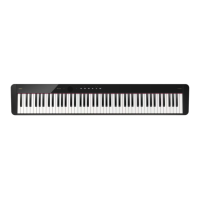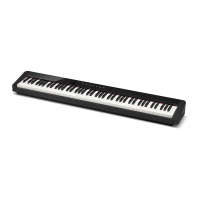EN-12
Your Digital Piano comes with 22 tones, including three grand
piano tones that are assigned to the entire keyboard range,
plus one bass tone that can be assigned to lower range only.
In addition to assigning a single tone to the keyboard, you can
also layer two different tones and you can split the left side
and right side of the keyboard between tones.
■ To select a tone using keyboard keys
1.
While holding down 8 GRAND PIANO, press
a keyboard key from A0 through F{2.
• For example, pressing the B1 keyboard key will select
the HARPSICHORD tone and will sound the
confirmation tone using the HARPSICHORD tone.
• For information about the tone assigned to each
keyboard key, see “Tone List” (page EN-63).
2.
Release 8 GRAND PIANO.
■ To select a tone with the touch buttons
Touching 8 GRAND PIANO selects the GRAND PIANO
CONCERT tone.
• If tones are currently layered (page EN-12) or if the
keyboard is split between two tones (page EN-13),
performing the above procedure to select a tones will
cancel the layer and split settings.
■ Grand Piano Tones
The characteristics of each of the three grand piano tones are
described in the table below.
Layering makes it possible to sound with two different tones at
the same time. The tone that is layered onto another tone is
the “Upper2 part tone”, which in this manual is referred to as
the “Upper2 tone”. The tone upon which the Upper2 tone is
layered is the “Upper1 part tone”, which is referred to as the
“Upper1 tone”.
■ To layer two tones
1.
Use the procedure under “Selecting a Single
Tone” (page EN-12) to select the Upper1 tone.
2.
Hold down 8 GRAND PIANO.
• Do not release 8 GRAND PIANO until step 5,
below.
3.
Press the B}4 keyboard key to enable layering.
• Each press of B}4 toggles layering between enabled
and disabled. A notification tone (page EN-11) will
sound to let you know whether layering is enabled or
disabled.
4.
Press a keyboard key within the range of A0
through F{2 to select the Upper2 tone.
• For example, pressing the C{2 keyboard key will
select STRINGS 1 as the Upper2 tone and will sound
the confirmation tone using the STRINGS 1 tone.
• For information about the tone assigned to each
keyboard key, See “Keyboard Function List” (page
EN-65).
5.
Release 8 GRAND PIANO.
• Now when you press a keyboard key to play, the two
tones (Upper1 and Upper2) you selected will sound at
the same time.
• To go back to playing with the Upper1 tone only,
disable the layer function.
• You can adjust the volume of the Upper2 part and configure
other Upper2 part settings. For more information, see
“Configuring Upper2 Part and Lower Part Settings” (page
EN-42).
• For information about adjusting the Upper1 part volume,
see “Adjusting the Upper1 Part Volume” (page EN-41).
Playing Notes with Different
Tones
Selecting a Tone
Selecting a Single Tone
Tone name Description
CONCERT A full concert grand piano tone for
dynamic and natural tone changes.
BRIGHT A bright and clear piano sound.
MELLOW A warm, subdued piano tone.
Layering Two Tones

